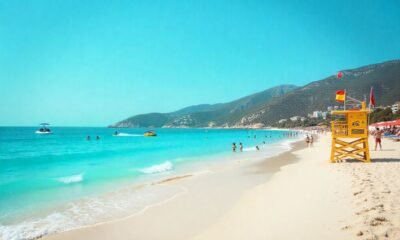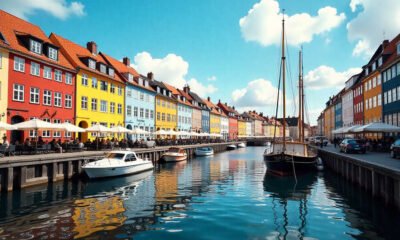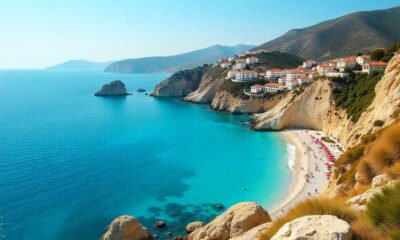Trip Planning
Now, P&O Aurora Marks 25 Years in Service: A Classic British Cruise Icon, Here is Everything You Need to Know About It
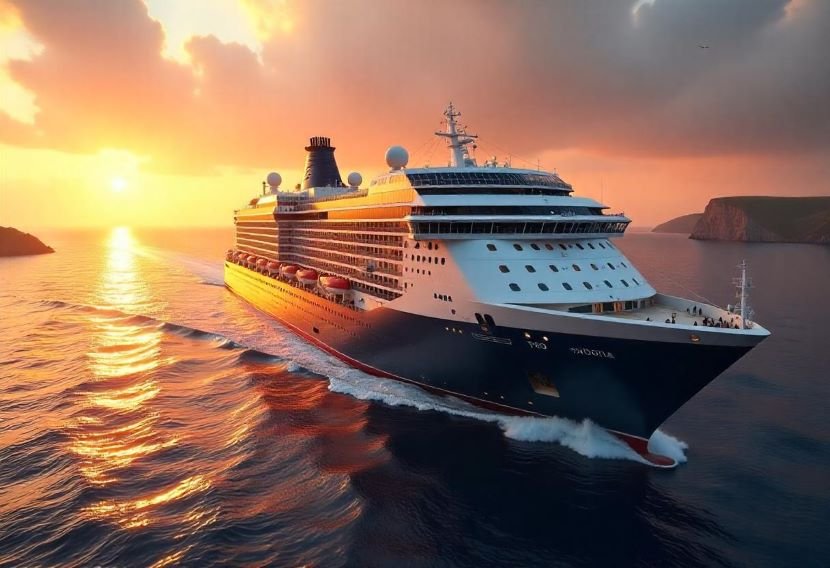
Sunday, July 20, 2025
The P&O Aurora, a pillar of British maritime elegance, is celebrating its 25th year of service. Launched in 2000, the ship continues to attract loyal cruisers with its refined ambiance, traditional entertainment, and globe-spanning itineraries.
Early Launch and Maiden Voyage
Aurora was built by the renowned Meyer Werft shipyard in Germany and entered the P&O Cruises fleet in spring 2000. It was finally delivered on April 15 and shortly sailed to Southampton.
Newcastle, then came a big christening with Princess Anne as godmother. A few short weeks later, the ship set sail on an exclusive pre-inaugural voyage.
Its inaugural official cruise began on 2 May 2000, a 14-night cruise in the Mediterranean. But mechanical problems ended the trip prematurely. The vessel overheated a propeller shaft bearing less than 18 hours after its departure and was forced back to port. Once refurbished, the Aurora returned to sailing with a cruise to the Canary Islands and, with that, its place within the P&O family was secured.
Classic Ship Décor and Onboard Refinement
The P&O Aurora was built to accommodate 76,000 tons with a maximum capacity of just over 2,000 passengers, giving passengers a more intimate cruising experience. It’s got the vibe of old school British luxury, with its traditional spaces and well thought out decor.
The passengers have the use of a full-size West End theatre, concert hall, five peaceful lounges, cinema and library. The ship’s atrium has been retained as a visual showpiece, with a cascading Lalique-inspired waterfall.
Aurora has developed a loyal following among older cruisers who enjoy its more sedate, adults-only ambience, smaller size and emphasis on service quality over scale.
Upgrades Over the Decades
To keep her luxurious feel, P&O Aurora has had several major refits. In 2014 the vessel has received a new and striking livery which includes a large Union Flag on the bow and a navy blue funnel.
Another update in 2019 also refreshed the public spaces, restaurants and lounges. In 2023 the balcony furniture is new and partly guest convenience systems have been optimized.
She was last dry-docked in April 2025. This consisted of modifications to the engines, cabin interiors, and common areas. Travelers reported carpeting, seating and atmosphere upgrades, although some wished for more updates to air-conditioning, lighting and in-room tech.
Aurora’s 2025 Itineraries
Aurora will again be based in Southampton in 2025, with a full season of immersive itineraries that showcase its long-range cruising credentials.
One of the most anticipated voyages is a 30-night roundtrip cruise to Canada and New England, slated for September. Stops on the itinerary include visits to Newfoundland, Quebec, Nova Scotia, and New Brunswick, as well as American ports in Maine, Massachusetts, New York, and Rhode Island.
The ship will also offer a 24-night Caribbean sailing, providing passengers with an opportunity to discover the sun-soaked islands. Adding to this, a 19-night Central Mediterranean cruise will allow guests to discover the beauty of historic European cities surrounded by art, rich culture and coastal allure.
These cruises are typical of Aurora’s signature long-haul voyages, particularly adored among passengers seeking in-depth exploration and fewer port hops.
Public Response and Operational Challenges
It has not been a comeback-free career for Aurora. The ship was unable to complete a short cruise to Zeebrugge with 24 hours’ notice back in 2025 because an extended shipyard maintenance period had been booked at a time when the sailings were on sale. The last-minute switch frustrated many passengers, though all were offered full refunds and a 20% credit for a future cruise.
Where such hiccups occur, the Aurora continues to be one of P&O’s most popular ships. Travelers consistently laud its friendly crew, peaceful atmosphere and classic design, even if some parts of the ship are showing wear and tear.
Looking Toward the Future
She is planned to remain in service until at least the early 2030s with further refinements. Shipyard engineers estimate the ship still has at least 5-10 more years of cruise operations assuming planned overhauls correct issues like ventilation, digital systems and balcony repairs.
There’s increasing demand from repeat cruisers for upgrades in soundproofing, lighting and smart-room amenities, all of which will likely be addressed in future updates.
A Quarter-Century Legacy
“And obviously it’s a big anniversary for Aurora, but it’s also a big anniversary for British cruising culture.” Few ships these days combine that classic polish and extensive itineraries lasting multiple weeks as Bliss does, and do so in an adult-only environment.
That is why Aurora has managed to survive, because they remain Aurora while allowing some renovations. It offers an authentic experience that stands in stark contrast to the enormous scale of today’s mega-ships.
This blend of heritage and ease keeps visitors coming back, year after year.
Source Credit: www.cruiseindustrynews.com
Trip Planning
More Aussies are using AI to plan holidays, from scoring deals to assembling itineraries

I’m planning a trip to Iceland, aka one of the most expensive countries in the world.
Can I afford to go? What would a realistic budget look like for a two-week holiday? How can I cut corners to save some cash?
I decide to do the 2025 equivalent of phoning a friend — I ask my buddy ChatGPT.
My initial prompt is too vague and it gives pricing in USD, which isn’t particularly helpful. I refine my criteria, asking for a rough total in AUD for a fortnight in September, departing from Perth (“please”, I add, because manners are still important when talking to a robot).
In the blink of an eye, Chat spits out a breakdown of average costs on everything from flights to accommodation, car rental, food and activities.
There are three tiers for backpacker, mid-range and luxury travel and an option to split components if I have a travelling companion.
It even offers suggestions for making my hard-earned coin stretch further, like buying groceries rather than eating out and opting to self-drive rather than joining a guided tour of the famous Golden Circle.
All in all, Chat reckons I’ll need to save $8500-$9000 to make Iceland happen.
What would have taken me hours of research and a lot of math just to ascertain whether I can even consider the trip in the first place was reduced to mere minutes.
Cutting corners, cyber style
While I want to give myself a pat on the back for being so resourceful — there’s a certain smugness that comes with finding a sneaky shortcut — I am hardly the first to use ChatGPT for travel tips.
In recent research conducted by Compare the Market, nearly a third of those surveyed admitted to using artificial intelligence to plan their holidays.
These Aussie respondents said they outsourced a range of tasks to AI, with the most common being destination recommendations, hunting for deals, seeking activities and finding accommodation.
Others reported they used AI to quickly create itineraries, scour flights or transport and understand currency conversion.
The data also gave insight into how different generations are embracing the technology — or not.
Perhaps unsurprisingly, gen Z and millennials are spearheading the adoption of AI when it comes to concocting their dream vacation, with 52 per cent and 44 per cent respectively utilising the tool to plan a holiday.
Meanwhile, 93 per cent of baby boomers and 76 per cent of gen X respondents said they were resistant to bringing AI into their trip arrangements.
Compare the Market’s Chris Ford says the stats reflect how we engage with the ever-changing tech landscape.
“Our latest data highlights a shift in the way travellers are approaching their planning, with convenience, personalisation and speed driving the adoption of innovative AI tools,” he says.
“It’s likely that travellers are using these tools in addition to chatting with travel agents, conducting desktop research or seeking ideas and inspiration from social media.
“AI is evolving at a rapid rate and as it becomes more accessible and intuitive, it’s not surprising that travellers are relying on new technology to help shape their dream holidays.”
But the insurer warns against taking AI’s word as gospel.
With nothing to validate the credibility of such recommendations, Ford says travellers need to practice due diligence.
“AI can be a great starting point when planning a holiday, but always ensure you’re crossing your ‘t’s and dotting your ‘i’s,” he says.
“Many of these tools and services are still in their infancy stage and may not be 100 per cent accurate, so do your own research to ensure you’re equipped with the right tools and information for your trip.
“The last thing we want to see is anyone getting themselves into a potentially dangerous or unsafe situation based on the recommendations from AI.”
The virtual line in the sand
Ford makes a crucial point here about our relationship with platforms like ChatGPT.
Rather than approaching them as one-stop-shop to curate every element of our holiday, we should instead consider them as a starting point to kick off deeper research.
After all, isn’t that part of the fun with travel — the anticipation in the lead-up, the process of discovering a destination before we have arrived and assembling a bucket list tailored to our specific taste?
By asking a computer to generate an itinerary based on what’s popular, we are depriving ourselves of creativity, spontaneity and adventure.
We must also remember that what the AI bot spits out is dependent on the quality of our prompts.
The more we refine our request, the more likely we will receive helpful answers, but even then things can go wonky.
Take this from my colleague Belle: “I asked ChatGPT to give me a child-friendly restaurant in Ubud. It sent me to a weird health food restaurant with a koi pond where you couldn’t wear shoes. My feral children cleared the room within minutes. Disaster.”
Then there’s the cognitive dissonance that comes with considering the environmental impact of AI versus the fear of being left behind if we don’t get on board with this technology.
Like it or not, it is shaping and re-shaping the future at breakneck speed.
We all have to decide where our (virtual) line in the sand is: what is productive and “mindful” use based on our needs and values.
For me, I’m OK with employing ChatGPT to whip up a quick budget so I can take the holiday to Iceland I’ve always dreamed of.
But when it asks if I want activity recommendations or a detailed itinerary next, I politely decline. I’d rather leave some room for mystery and exploration.
“Thanks”, I farewell my cyber mate in my sign-off (because, manners).
What the team thinks
Our collective of writers just so happens to represent the four age demographics mentioned in the research above. So what’s the hot take?
Stephen Scourfield — baby boomer
Trusting someone – or, in this case, something – to book a holiday (particularly a family holiday!) requires a lot of trust.
If some detail is missed in the booking process (a wrong date, a badly timed connection), it will be you standing there, somewhere, trying to fix it (possibly with the family “on your case”).
Would I trust AI yet?
No – not yet.
Of course, I think we all know that AI is good at doing grunt work and it is up to us to check details. So AI is already useful for the broad-brush, first sweep of mapping out a holiday.
But AI won’t then back itself by booking it all. (That will be the game changer.)
So, at this stage, AI, for me, is still a basic tool of research – not a replacement for an experienced and knowledgeable travel agent.
Leyanne Baillie — gen X
Although my generation is confident when it comes to using tech (even if we’re not digital natives), I think AI programs would be more effort than they’re worth.
I know it could be a time-saver in terms of journey-planning brainstorming and getting a rough guide of options, but I’d still want to tailor my itinerary to cater to my personal taste.
I don’t think I’m ready to hand over the reins completely to artificial intelligence just yet.
Jessie Stoelwinder — millennial
I love a good travel hack, and that’s how I have been approaching my use of AI.
Anything that makes life a little easier and frees me up to investigate the fun stuff — where to eat, hike, shop, people-watch etc. — and I am on board.
I’ve used ChatGPT to quickly aggregate travel data for personal trips to assist with admin, logistics and practicalities, which I will then cross-check and verify to make sure the information works for me.
Recommendations, however? Word of mouth and insider intel from a human being will always win, in my opinion.
Megan French — gen Z
I would be open to the idea of utilising AI when planning my travels but I’d take everything it recommends with a grain of salt while still doing my own thorough research.
I think it’s great for foundational information-based planning early in trip preparations, such as “what holidays are on in India during July and how is best to navigate them?”
But when it comes to booking flights and accommodation, I’d go nowhere near AI … yet.
Trip Planning
Travel experts share their once-in-a-lifetime itineraries for hidden Ireland

“My first tour was in 1998, right after the Omagh bomb. So it was quite the strange time,” says Ginger Aarons.
From the peace process and the Celtic Tiger to the advent of a multicultural society, the travel expert and genealogy enthusiast has seen huge changes across the island of Ireland in the 27 years she’s been bringing clients here on tailor-made travel trips.
And she’s not alone. Her fellow bespoke tour operators, Kate McCabe and Max Sussman of Bog & Thunder and Rachel Gaffney of Rachel Gaffney’s Real Ireland, have also been blazing a trail from the US to highlight a 21st-century vision of Ireland to their clients, and each have their own take on what that is.
Their tours are high-end, once-in-a-lifetime experiences, but all are agreed on one thing: luxury is not necessarily about helicopters, champagne, and five stars.
It’s to be found in those magical moments of connection, a hidden Ireland that’s there, waiting to be revealed, if we just give it the opportunity to do so.
“Take your time. Otherwise you’re just doing a drive-by,” is what Cork woman Rachel Gaffney advises the Americans for whom she organises bespoke tours of Ireland.
“Allow Ireland to unveil herself, because she will,” says the Dallas-based slow-travel advocate.
Gaffney moved to the States in 1996, having worked in the Irish and UK hotel industry for decades.
She set up her own travel company, Rachel Gaffney’s Real Ireland, when she moved Stateside, and every year spends 12 weeks in Ireland doing on-the-ground research of what’s new and what will chime with her clientele, who, typically, “have a home in Aspen, and a home in Palm Beach, a home here, and a home there”.
“They have pretty high standards,” she says. “They may say they’re low maintenance, and in fairness, most are. Just get it right for them, that’s all they want.
“I have a plan, but I don’t have a plan,” she says of her annual deep dive into what Ireland has to offer.
Coupled with her natural curiosity and an instinct for the new and unusual, what unfolds for her clients is an eclectic mix.
While super-luxe spots invariably feature — “Ashford and Ballyfin, those are the no-brainers. I send people there because I want them to experience that” — if a place can meet her exacting standards, it stands a chance of making the cut.
“I love Perryville House in Kinsale. Their breakfast is one of the most gorgeous in Ireland.”
Gaffney has an eye for perfection, and the custom luggage racks in Perryville’s rooms — no bending down required — merit special mention: “the ergonomics of how you travel was thought about”.
“I’m matchmaking,” Gaffney says of her role as curator of a bespoke offering. “I’m putting clients in the right place for them.”
The “truly spectacular” Dunluce Lodge in Co Antrim, is one of her recent discoveries, and only opened its doors this spring.
“When I visited, they were working on a putting green, which will be the largest putting green in Ireland. It’s for the residents. So, in the evening, you can sit overlooking the sand dunes and the fourth fairway of Royal Portrush and the ocean. Then, if you like, you can walk outside and practice your putting by a fire pit.”
Gaffney likes to immerse herself in a place. “I sit in bars and restaurants by myself. I talk to people. I want to see what’s happening in the area. I want to get a feel for the area, a sense of it.
She rates Clare, calling the county one that’s “really starting to punch above its weight”, and namechecks Doolin’s Fiddle and Bow — “the natural colours, the simplicity, the bare floorboards; they brought the outside in” — and the Michelin-starred Homestead Cottage: “It’s literally in the middle of nowhere.”
“I’m finding some of the best hospitality is in the most inaccessible places. If I send people, they’ll throw the red carpet out for them. They’ll just be so delighted to have you.” Cork is close to her heart too, with one of her “most favourite hotels”, Clonakilty’s Dunmore House, sparking memories of a past trip. Gaffney had spontaneously decided to organise a morning yoga class for a group of ladies on an adjacent tiny beach and the hotel staff stepped up to elevate their experience.
After the yoga “what happened was these women, who were in their 60s and 70s, forgot themselves. They were running up and down to the water, making sandcastles. The head gardener had made a fresh-flower crown for the creator of the best one,” Gaffney recalls.
“The hotel staff brought us blankets and a picnic of strawberries and fruit from their garden and cheeses from the English Market. We were still there at four in the afternoon. It was the best day ever. Then the ladies went back to the hotel and had this fabulous dinner and sang songs in the bar. Just magical. That’s luxury.”
- Wilder Townhouse, Adelaide Rd, D2: “It was a mansion for retired school governesses. The history in that building is so interesting.”
- Vandeleur Walled Gardens, Kilrush, Co Clare: “Spectacular.”
- Barrow House in Tralee: “A white Georgian manor house overlooking Barrow Bay.
- Ekotree knitwear, Doolin, Co Clare: “The finest cashmere gloves I’ve ever seen.”
Dubliner Maeve Brennan, a staff writer for The New Yorker in the last century, had no time for cliches about her homeland, decrying “the bog and thunder variety of stuff that has been foisted abroad in the name of Ireland”.
Her adjectives provided the perfect name for McCabe and Sussman’s bespoke travel business, which has an eco-tourism and sustainability focus and operates out of the duo’s Ann Arbor, Michigan base.
“We’re trying to frame Ireland as the modern country that it is. We love the Aran sweaters and we love sheep and we love pubs and all that kind of stuff. But Ireland is so much more than that,” McCabe says.
“We do three types of travel,” explains Sussman, who’s also a chef. “Private itineraries for people who want to plan their own trip; group trips, and retreats.”
The retreats are “a way for us to get more deeply embedded in a specific place,” McCabe says.
For their third annual writing retreat this year, they are staying in Within The Village, “a really special place” in Roundstone, Co Galway.
Last year, Max cooked for the group, and they enjoyed a pop-up by Westmeath-based chef Rose Greene of sustainable fermented food business 4Hands Studio.
Bespoke food tours and curated culinary experiences are a large part of the Bog & Thunder offering.
Two decades ago, New Jersey native McCabe, whose dad is from Tullamore and has connections to Belfast through her maternal grandmother, was “doing political work around some of the outstanding issues of the peace process” as a college student, and it led to her travelling to Derry and Belfast.
After graduation, she continued to visit Ireland and Max, whom she’d met in college, came too.
“We don’t do typical food tours,” explains McCabe, whose background is in environmental policy and sustainability. “When we design our tours, we usually have a theme or a narrative that we’re telling throughout the tour. We’re doing a tour in August with Youngmi Mayer, a Korean-American comedian whose paternal grandmother is from Cork. She just published a memoir where she talks about being Irish and not really being accepted for being Irish because she looks Korean. She’s never been to Ireland before.”
Everyone will “eat amazing food”, McCabe says, and there will be talks on “Irish history and colonisation and immigration and emigration, to ground people in the themes that Youngmi talks about in her book.”
The duo like the value of involving people “who aren’t necessarily guides” in the tour conversations and are also passionate about “trying to translate to people, whether they come on guided trips or do our private itineraries, how much of a multicultural nation Ireland is”.
They feel hidden Ireland still exists, but like Gaffney, emphasise the need to venture off the beaten track to find it. “Give yourself a little bit of time and freedom to explore a little bit. Every time we’re in Ireland, we meet new people who are doing incredible things.”
Once again, the Antrim coast comes up. “One of our favourite bakeries in Ireland is Ursa Minor in Ballycastle.” Lir, a seafood restaurant in Coleraine, also gets the nod. “We like to send people there,” McCabe says.
“It’s a very beautiful spot, they’re very into sustainable seafood, and sustainability is a pillar of our organisation. We like to connect travellers with people that are really walking the walk and actually translating their ethics into the food that they serve in their restaurants.”
Another sustainable seafood spot they love is Goldie, on Oliver Plunkett Street in Cork, while the city’s Izz Café is cited as a “great example of an immigrant couple who moved to Ireland and started a food business”.
Baltimore’s two Michelin star Dede, which they acknowledge as likely to be already on people’s radar, is “one of the best restaurants in Ireland”.
One of the things that makes it really special, in addition to the food, is how warm and hospitable it is,” McCabe says.
“And I’d be remiss if we were to talk about Co Cork and not mention our dear friend, Sally Barnes, the only fish smoker on the island of Ireland to work exclusively with wild fish, which is something that we consider really important.”
Since 2022, McCabe and Sussman have hosted a podcast, Dyed Green, exploring Irish food and culture, and the duo have “a medium-term goal of moving to Ireland. We’d love to own and operate a B&B with a food component one day.”
- Native Guest House, Ballydehob: We just organised a private writing retreat for some clients there.
- Seaweed & Saltwater camper vans: For travellers who really want to get off the beaten path and travel sustainably, they have a small fleet of eco-friendly luxury Mercedes Sprinter camper vans. They’re both off-grid AND high end, and you can shower and enjoy a good night’s sleep on quality sheets.
- Dingle Sea Salt: A project run by Tom Leach & Moe McKeown, two surfer-scientists who hand harvest and use polytunnels to evaporate all of their salt.
Yes, it’s her real name, Ginger Aarons tells me over Zoom from Portland, mentioning the Duke of Abercorn is also a sceptic: “he can’t imagine anybody would ever christen me Ginger”.
That impressive namedrop is a clue as to one of Aarons’s areas of expertise, genealogy; the flame-haired entrepreneur is also a master gardener, and combines these passions in her bespoke travel business, Time Travel Tours.
She’s been bringing clients to Ireland to find their lineage since 1998, and can trace her own paternal Maguire ancestry back to the Flight of the Earls in the 17th century.
On her mother’s side, Aarons’s Dublin-born ancestor arrived “in Virginia about 1710”, meaning her US ancestors predate the founding of the United States. “My forefathers fought in the Revolutionary War.”
While her own expertise is considerable — “Ashford Castle uses me for their genealogy” — she recruits experts, such as historic garden consultant and plantsman Neil Porteous and architectural historian Robert O’Byrne, “so that everybody gets a well-rounded look at Ireland and at the history”.
“Taking people around to the gardens in Ireland is fantastic, and I have so much support — at Mount Stewart, Lady Rose came in and they gave us a Champagne welcome. I have great people on the ground.”
Her genealogy tours have a maximum of 12 participants. While they research in libraries and pore over records in great houses, her clients also frequently find themselves in graveyards in search of an ancestor’s resting place, with everyone helping each other in their quest. She has long worked with Historic Houses of Ireland but a new venture will see her promoting education around them and giving “the Irish people more reason to go to these houses, whether it’s for a concert or a country weekend”.
Also in the works is an associated educational film, and a book “Dogs of Historic Houses, which is going to be from the dog’s point of view”.
Aarons believes that hidden Ireland is to be found in these historic houses, some of which have new owners who are bringing new life to these “hidden gems”, as they welcome paying guests for the first time and find inventive ways of making their properties generate income.
Over the course of a fortnight, Aarons’s garden tour clients often see three gardens a day, but the pace is never rushed, and food is always an integral part of the tailor-made experience.
“We do a salvia class at Jimmy Blake’s and then go to Russborough House for lunch and a history tour. We’ll meet the Royal Horticultural Society of Ireland volunteers who look after the walled garden at Russborough, and then go to June Blake’s [near Blessington] for afternoon tea.”
This September, Aarons’s garden enthusiasts will be enjoying cookery lessons from Paul Flynn at Dungarvan’s The Tannery, another “hidden gem”, and stopping off at Manning’s Food Emporium, near Ballylickey in Cork.
“I’ve been going there for 25 years. We’ve had little kids come in and do their music and dancing. Then we’d have our picnic lunch and go to Bantry House for the history and the gardens. We’ll be doing that again.”
A new trend Aarons has noticed is more people visting Ireland for sport.
“They want to see games, even if it’s a local hurling or soccer game. People are very interested in what Irish people do in daily life.”
- Enniscoe House, Co Mayo. “You can do a lot of walking and fishing, enjoy a glass of whiskey by the fire, and they allow dogs stay.”
- Dunraven Arms Hotel, Adare, Co Limerick: “A great little hidden gem.”
- virtualtreasury.ie: A virtual reconstruction of the Record Treasury and its records which were lost in a fire in 1922. “You can research your ancestry, and look up wills and all kinds of letters on there.”
Trip Planning
Audley Travel reintroduces Jamaica after three-year gap
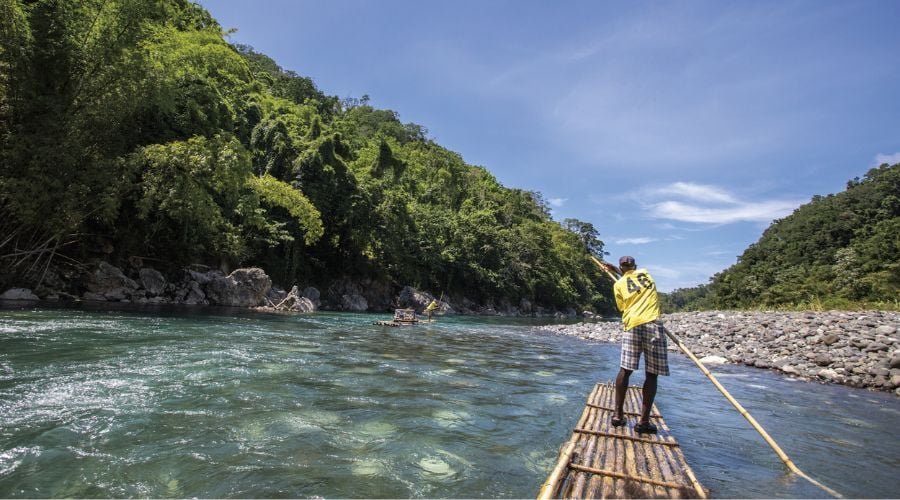
Audley Travel has relaunched its programme to Jamaica three years after pulling out of the destination.
The tailor-made tour operator said it had reintroduced the country due to client demand for more Caribbean islands.
A sample itinerary to Jamaica includes a nine-day ‘Jamaica beach & rainforest escape’ with stays in Ocho Rios and Montego Bay. Other itineraries include a tour of Kingston and a visit to Dunn’s River Falls and The Blue Hole.
Audley has also expanded its programme in India, Japan and Tanzania.
New tours in India include a 15-night tailor-made itinerary, with stays in Delhi, Nimmu, Uleytopko, Nurla, Leh, Nubra Valley and two nights at the Drenmo Lodge. There’s also bear tracking in the valleys of Dras, where guests can stay in the Drenmo Lodge for the chance to see the Himalayan Brown Bear.
In Japan, Audley has added Nagoya in Aichi Prefecture, which can be included in a traditional Japanese itinerary to expand the Golden Route. A sample itinerary includes a 17-day trip with two nights in Nagoya as well as time in Tokyo and Kyoto.
The expanded Tanzania programme includes a 10-day itinerary with one night in Arusha, four nights for the Great Rift Valley Trek and two nights in Karatu.
-

 Brand Stories2 weeks ago
Brand Stories2 weeks agoBloom Hotels: A Modern Vision of Hospitality Redefining Travel
-

 Brand Stories1 week ago
Brand Stories1 week agoCheQin.ai sets a new standard for hotel booking with its AI capabilities: empowering travellers to bargain, choose the best, and book with clarity.
-

 Destinations & Things To Do2 weeks ago
Destinations & Things To Do2 weeks agoUntouched Destinations: Stunning Hidden Gems You Must Visit
-

 Destinations & Things To Do1 week ago
Destinations & Things To Do1 week agoThis Hidden Beach in India Glows at Night-But Only in One Secret Season
-

 AI in Travel2 weeks ago
AI in Travel2 weeks agoAI Travel Revolution: Must-Have Guide to the Best Experience
-

 Brand Stories4 weeks ago
Brand Stories4 weeks agoVoice AI Startup ElevenLabs Plans to Add Hubs Around the World
-

 Brand Stories3 weeks ago
Brand Stories3 weeks agoHow Elon Musk’s rogue Grok chatbot became a cautionary AI tale
-

 Asia Travel Pulse4 weeks ago
Asia Travel Pulse4 weeks agoLooking For Adventure In Asia? Here Are 7 Epic Destinations You Need To Experience At Least Once – Zee News
-

 AI in Travel4 weeks ago
AI in Travel4 weeks ago‘Will AI take my job?’ A trip to a Beijing fortune-telling bar to see what lies ahead | China
-

 Brand Stories4 weeks ago
Brand Stories4 weeks agoChatGPT — the last of the great romantics

